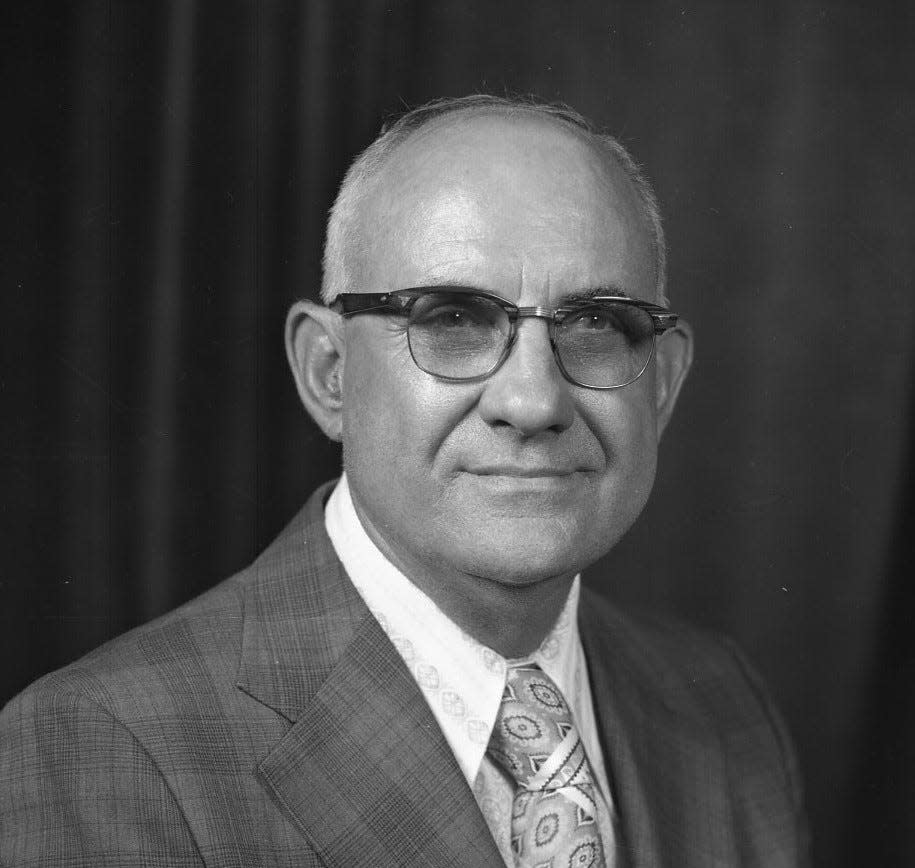Weston Wednesday: Nola Jane Gray memories, Part 1

Editor's Note: In collaboration with the Bartlesville Area History Museum, the Examiner-Enterprise has revived the late Edgar Weston's 'Revisiting the Past' columns that ran in the newspaper from 1997-99. Weston's columns recount the history of Bartlesville as well as Washington, Nowata and Osage counties.
Nola Jane Gray came to Bartlesville in 1898. The following is her personal account of what transpired from when she first arrived until April 1959.
Bartlesville really began when Jacob H. Bartles founded the town and after whom the town was named. Bartles purchased the corn grist mill from Nelson Carr and enlarged it and converted it into a flour mill beginning in 1875.
In 1877, Bartles built a two-story frame building north of his mill on the northside of the Caney River. The lower floor was used as a general store and the upper story was the Bartles family home. He also built a rock dam on the rock ford in the river to furnish more water power to run the mill.
Johnstone and Keeler’s little settlement on the southside became the incorporated town of Bartlesville, in Indian Territory, January 15, 1897.
Town marshals and U.S. Marshals preserved the law during the Indian Territory period. Whiskey and peddlers were the most troublesome law violators and they were taken care of by the marshals. During the Fourth of July celebrations, they would arrest their victims and tie them to trees with chains, until the celebration was over, and then take them to the Federal Jail at Muskogee.
For about twenty-three years, or until 1898, it remained a small place and grew slowly. About 1899, after the Santa Fe train came into Bartlesville and the first oil well was drilled down in the park, the oil boom started and Bartlesville really began to grow, and an oil boom developed.
When I landed in Bartlesville April 7, 1898, I came from Caney, Kansas by mail hack. The railroad was completed into Bartlesville, but trains ran no further than Caney, Kansas. I made the first stop at Bartles Store on the north side of the river. There were no bridges and we had to ford the river. The crossing started in just below the Bartles Store and came up on the south side about where the city park is on north Delaware. When the river was up and we could not ford the river, there was a ferry we crossed on. It started across the river about where the water tower stands down by the first oil well, and came up on the north side about where the park superintendent has his home. I crossed that ferry once, soon after I came here with a nice young U.S. Marshall on our way to Muskogee as a witness on a whiskey trial. I made three trips on that business. One to Muskogee, one to Claremore and one to Vinita.
Coming back to when I first came and crossed the river, I had them to take me to Third and Delaware where Mac and Mac's store now stands. (Note: In 1997, TECO Home Appliances was later at that location). John and Jim Gray, who came from Virginia to Bartlesville in 1895, were getting ready to open what they called the Dollar Store. I had them take me there because I knew Jim. His wife was a cousin of mine, and they were the only two I knew here at that time.
John was not in the store when I arrived, he had been out in the country all afternoon posting signs telling of the opening of the Dollar Store. Not long after I got there he came in and I met him. Their Aunt Frankie lived just east of where the courthouse stands and John was living in her home. I went there for supper. Jim lived further east of Aunt Frankie's on what is known as the Jim Gray Lake. (Note: Jim Gray Lake, is the location of the paper shelled pecan grove between north of Frank Phillips Boulevard and Tuxedo Blvd. Jim Gray Lake was a great place to ice skate in the winter, until the lake was drained and filled in enough to make a pecan grove). After supper, we went there and I stayed with them. There was nothing east of where Aunt Frankie and Jim lived but a big wheat field.
I arrived on Friday and Sunday afternoon, we saw coming across the wheat field a buggy and a double team. It proved to be John and we spent the afternoon driving through the country. We developed a friendship which grew stronger and sweeter and in two years, October 4, 1900, we were married.
The Gray brothers opened the Dollar Store the first day a white man could do business in the Indian Territory without some kind of Indian connection. I want to explain that, or you may not understand the terms I use. I want you to know that I think the Indian people are wonderful people and the ones who were in business at that time were tops. I am using the term white man and Indian simply to make plain to you what I mean when I say they went into business in the Indian Territory without some kind of Indian connection. Those who were in business at that time: William Johnstone, Nell Cannon's father was a white man, his wife was an Indian. Jake Bartles was a white man, his wife was an Indian. Frank Overlees was a white man, his wife an Indian. George Keeler was a white man, his wife an Indian. Mrs. Frank Overlees and Mrs. Johnstone were sisters. Mrs. Bartles and Mrs. Armstrong were their aunts and daughters of Chief Charles Journeycake.
Next week I will tell you more…..
This article originally appeared on Bartlesville Examiner-Enterprise: Weston Wednesday: Nola Jane Gray memories, Part 1

